How to Design Drawing Room: Expert Tips & Ideas
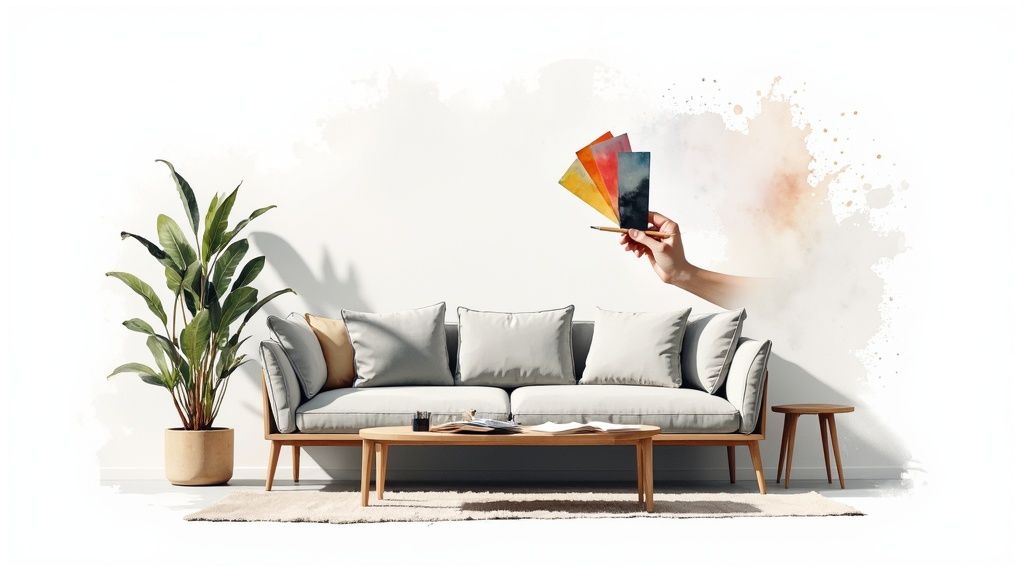
Before you even think about paint swatches or fabric samples, the most crucial step in designing your drawing room is to pin down its real purpose. It’s easy to get swept up in the aesthetics, but first, you have to decide what this room is truly for. Is it a formal space for entertaining guests, a laid-back family hangout, or maybe a hybrid that needs to do a little bit of everything?
This one decision is the bedrock of your entire project. It’s what will guide every single choice you make from here on out.
Getting to the Heart of Your Drawing Room
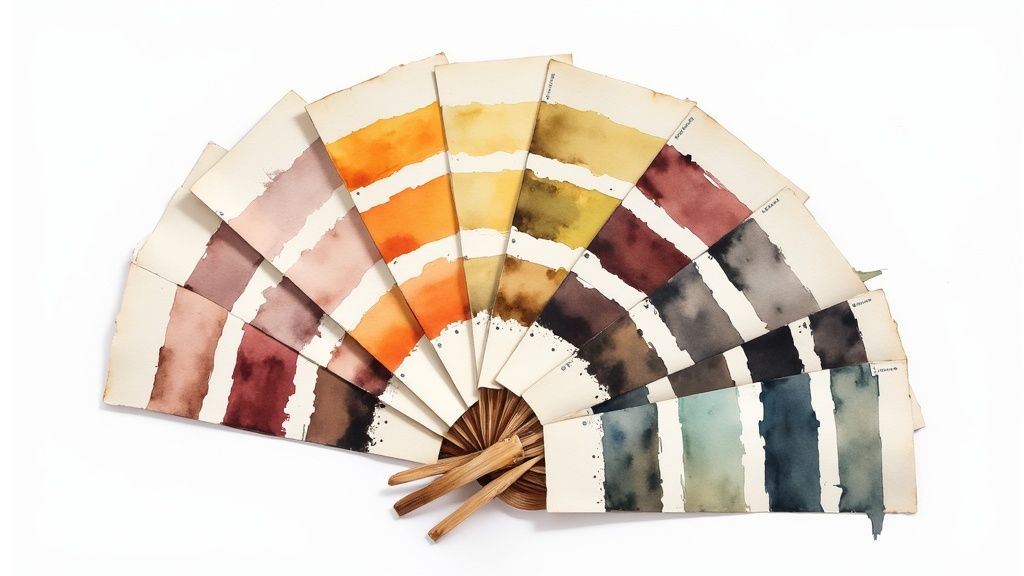
It’s tempting to fall for that gorgeous velvet sofa you saw online, but hold that thought. Let’s get brutally honest about how you and your family actually live. A drawing room that looks like it’s straight out of a magazine but doesn’t fit your lifestyle will just end up being a beautifully frustrating space you never use.
The goal here isn’t just to make it pretty—it’s to make it work for you. Think about your daily and weekly routines. Are you the go-to host for dinner parties? Is family movie night a non-negotiable event? Or do you desperately need a quiet corner to curl up with a book? Each of those scenarios calls for a completely different approach.
What’s the Room’s Main Job?
To figure this out, you need to ask yourself some direct questions. The answers will become the blueprint for your design.
- Who is this room really for? Is it an adults-only sanctuary, or will it be crawling with kids and pets? This answer immediately influences your choices in fabrics, furniture durability, and even the layout.
- What’s the number one activity here? Try to nail down its primary function. Is it all about conversation, binging the latest series, quiet reading, or something more formal? Whatever it is, that activity should inform the room’s focal point.
- What’s the vibe you’re after? How do you want to feel when you walk in? Are you aiming for cozy and intimate, or light and airy? Words like “formal,” “relaxed,” “energetic,” or “serene” will point you toward the right colors and textures.
Going through this exercise saves you from creating a generic, soulless room. A family-centric space, for instance, would probably benefit from a massive, comfy sectional and durable, stain-resistant fabrics. On the other hand, a drawing room meant for formal entertaining would call for elegant, individual seating arranged to spark conversation.
Finding Inspiration That Actually Works
With a clear purpose in mind, you can start the fun part: gathering inspiration. This can get overwhelming fast, so instead of just endlessly scrolling, be strategic. Create a mood board—whether physical or digital—that aligns with the function and feeling you just defined.
And don’t just look at the big picture. Dig into the details of the rooms you love.
- Lighting: Notice how the best rooms layer their lighting. Do they use a mix of lamps, sconces, and overhead fixtures to create ambiance?
- Texture: See how different materials are combined. A good mix of wood, metal, linen, and wool can add a ton of depth and make a space feel complete.
- Layout: Pay attention to how the furniture is arranged. Does the layout in an image you saved seem perfect for the kind of conversations or movie nights you have in mind?
This is where a tool like RoomGenius can be a game-changer. You can upload a photo of your own room and start playing around with different styles and layouts without any heavy lifting. It lets you see how a minimalist design feels versus a traditional one, helping you make confident decisions before you spend a dime.
A well-defined purpose is the anchor of any successful design project. It transforms a room from a collection of nice things into a cohesive space that enhances your daily life.
To get more ideas flowing for your project, it’s always helpful to check out some free interior design resources and tips. With a clear vision in hand, you can move forward knowing the final design will be both beautiful and perfectly suited to your life.
Creating a Functional and Flowing Layout
The real secret to a stunning drawing room isn’t just about the beautiful furniture you pick out—it’s about where you put it. A thoughtful layout is the invisible framework that makes a room feel right. It’s what separates a space that’s inviting and easy to move through from one that just feels awkward and clunky.
So, let’s get practical and map out a floor plan that actually encourages conversation and feels completely natural.
Every great room design starts by identifying a focal point. This is the anchor of your space, the first thing your eyes are drawn to when you walk in. It might be an architectural feature you already have, like a grand fireplace or a large window with a killer view. If your room doesn’t have a natural one, no problem—you can create one. Think a dramatic piece of art, a sleek media console, or even a bold accent wall.
Once you’ve got your focal point locked in, you can start arranging your seating around it. The idea is to create cozy, conversational zones where people can easily interact without having to shout across the room.
Mapping Your Furniture Placement
Before you even think about dragging a heavy sofa across the floor, let’s talk about spacing. These aren’t strict rules, but rather time-tested guidelines that make a room feel comfortable and work for real life. A little planning upfront will save you a ton of back-breaking work and second-guessing later.
This quick guide breaks down a simple, three-part approach to nailing your furniture placement from the get-go.
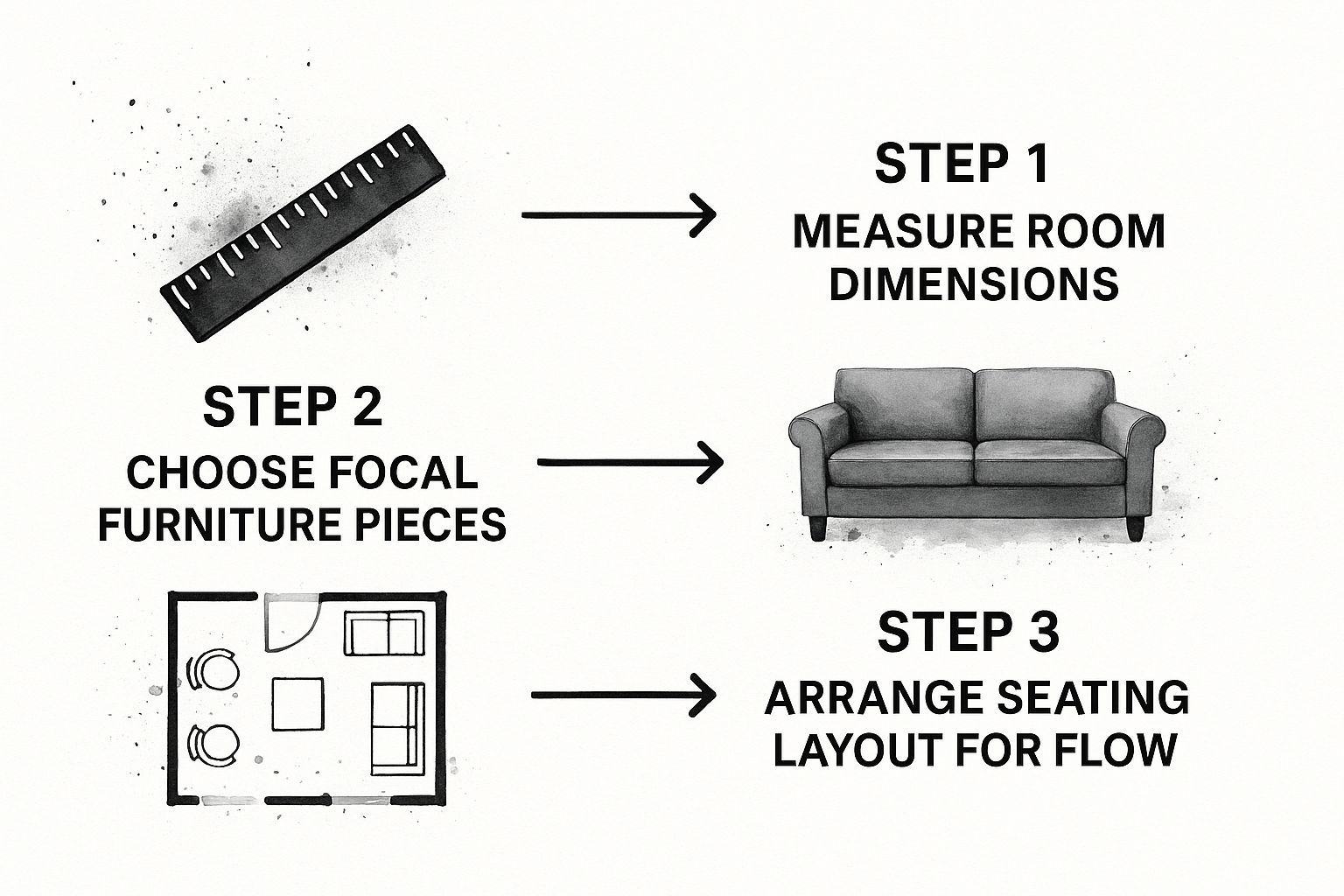
As the visual shows, it boils down to measuring your room, picking your main furniture pieces, and then arranging them to create a natural flow. This last step is what truly makes or breaks a drawing room design.
Getting the balance right is about more than just numbers; it’s about creating a certain feeling. For example, one of the most common mistakes I see is people pushing all their furniture flat against the walls. Just pulling your sofa 3-5 inches away from the wall can create a little breathing room and make the entire space feel bigger and more professionally designed.
Pro Tip: Try to keep your coffee table no more than 4 inches higher or lower than the seat cushions of your sofa. This simple trick keeps the visual lines clean and makes the table a comfortable height to actually use.
The Power of Virtual Planning
Let’s be honest, physically moving furniture around is a massive pain. A much smarter way to work is to play with your layout digitally first. This is where a tool like RoomGenius really shines. You can just upload a photo of your empty drawing room and start experimenting with different arrangements without lifting a finger.
See how a huge sectional really feels versus two separate sofas. Test whether an L-shaped setup opens things up better than having your couches face each other. This kind of digital trial and error is a core part of effective space planning, which is a whole design discipline on its own. If that term is new to you, you can dive deeper into what is space planning in our detailed guide.
Virtual tools give you the freedom to mess up and find the perfect layout before you commit to buying anything or calling in friends to help you move heavy stuff.
Key Spacing Rules for a Comfortable Room
To help you design a drawing room that looks great and feels even better, here are a few key measurements I always keep in my back pocket:
- Walkway Clearance: You need 30 to 36 inches of clear space for the main walkways. This gives people enough room to move around comfortably without having to turn sideways.
- Sofa to Coffee Table: The sweet spot here is between 16 and 18 inches. It’s close enough to easily reach your drink but leaves enough legroom.
- Seating Distance: For a good conversation, place chairs and sofas no less than 3.5 feet and no more than 10 feet apart. Too close feels crowded; too far, and you’ll be yelling.
- Accent Chairs: If you have a pair of accent chairs, try to leave about 42 inches between them. This gives you the perfect amount of space to pop a small side table in the middle.
Stick to these guidelines, and you’ll create a drawing room that’s not only beautiful but also a genuinely pleasant place to be. When you plan your layout with intention, you design a space that invites people to relax, connect, and stay awhile.
Picking Your Palette and Weaving in Texture
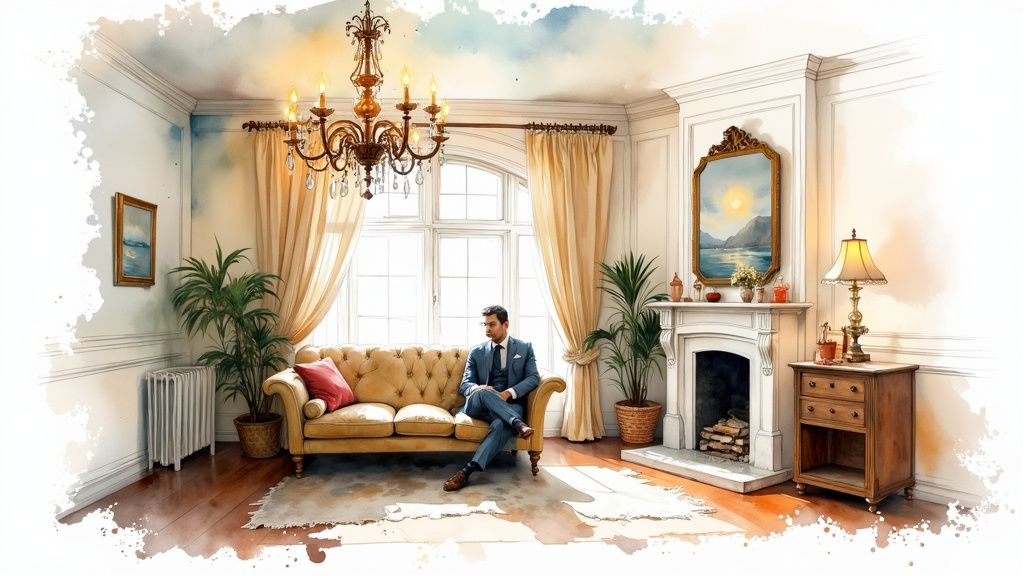
If your floor plan is the skeleton of the drawing room, then color and texture are its heart and soul. These are the elements that breathe life into a space, turning a collection of furniture into a room that feels genuinely yours. The right palette can make a room feel like a calm oasis or an energizing hub, instantly setting the mood.
Texture is just as critical. It’s the difference between a room that just looks good and one that feels incredible to be in. When you mix materials—think soft linens, rugged wood, cool metals—you create a rich, tactile world that invites you to come in, sit down, and stay awhile.
Starting with Your Color Foundation
The best way to avoid a color catastrophe is to lean on a tried-and-true designer’s trick: the 60-30-10 rule. It’s a simple framework that keeps your color scheme feeling balanced and intentional, preventing any one color from taking over.
Here’s the breakdown:
- 60% Dominant Color: This is your room’s anchor. It’s usually the color on your walls, for your largest rug, or maybe even a sectional sofa.
- 30% Secondary Color: This shade supports the main color and adds interest. Think curtains, accent chairs, or smaller furniture pieces.
- 10% Accent Color: This is where you get to have fun! It’s your pop of personality, used for things like throw pillows, artwork, or decorative objects. Go bold here.
So, a calming room might use a soft greige for its 60%, a deep navy as its 30%, and a splash of warm mustard for the final 10%. This structure gives you a solid foundation but leaves plenty of room for your own creative spin. For a deeper dive, check out our complete guide on how to choose color schemes for any room.
A Quick Note on Color Psychology: Color has a real impact on our mood. Blues and greens tend to create a sense of calm, while warmer tones like reds and oranges can bring energy. Always think about the feeling you want to create before you fall in love with a paint chip.
The Art of Layering Textures
With your colors figured out, it’s time to add depth. A room filled with nothing but smooth, flat surfaces can feel sterile and one-dimensional, no matter how great the color scheme is. Layering different materials is what makes a space feel curated, cozy, and lived-in.
Think about creating contrast to engage the senses. It’s all about the mix.
Great Texture Pairings to Try:
- Smooth with Rough: Imagine a sleek leather armchair with a chunky knit throw draped over it.
- Hard with Soft: Place a cool marble coffee table on top of a plush, high-pile wool rug.
- Natural with Man-Made: Combine a rustic, live-edge wood console table with accents of polished chrome or brass.
This thoughtful combination of materials is what gives a drawing room its unique character. It makes the space feel like it was collected over time, not bought straight from a catalog page.
Embracing Sustainable and Mindful Materials
As you choose your materials, there’s a wonderful shift happening toward choices that are both beautiful and kind to the planet. The best modern drawing rooms are increasingly reflecting this desire for sustainability, proving that style and responsibility can go hand-in-hand. This isn’t just a passing fad; by 2025, it’s expected that consumer preferences will lean heavily toward sustainable materials like reclaimed wood, bamboo, and recycled metals.
These materials do more than just reduce your environmental footprint. They bring a unique story and an artisanal quality into your home. A coffee table crafted from reclaimed timber or a light fixture made from recycled metal becomes a stunning focal point—and a great conversation starter—that adds a layer of purpose to your design.
Selecting Furniture with Style and Purpose
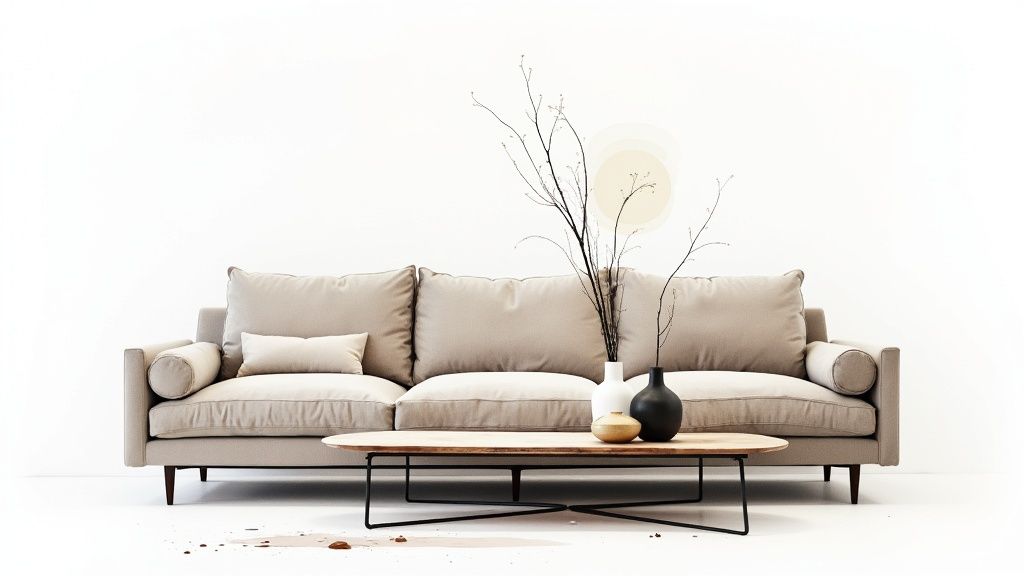
Let’s talk about furniture. It’s so much more than just stuff to fill a room—it’s what gives the space its soul. When you’re figuring out how to design a drawing room, picking the right pieces is where you get to master the art of balancing beautiful design with how you actually live. This is your moment to invest in things that don’t just look incredible but truly work for you day in and day out.
The goal here is a curated feel, not a cluttered one. It’s all about choosing a few “hero” pieces that make a statement and then surrounding them with supporting furniture that complements them without competing for the spotlight.
The Anchor Piece: Your Hero Furniture
Every drawing room that really works has an anchor piece. This is the item that grabs your attention and sets the tone for everything else. Most often it’s the sofa, but it could just as easily be a stunning pair of armchairs or a uniquely crafted coffee table. This is where you might want to spend a little more of your budget because its impact is huge.
Think about the message you want to send. A deep, cozy sectional practically shouts “come hang out and relax,” while a sleek, low-profile sofa with sharp lines points to a more formal, modern vibe. Whatever you choose, it should tie directly back to the room’s main purpose that you decided on earlier.
Balancing Scale and Proportion
One of the most common missteps I see is getting the scale all wrong. A massive, overstuffed sofa will absolutely devour a small drawing room, making it feel cramped. On the flip side, delicate, small-scale furniture can look completely lost and out of place in a large, airy room. Visual harmony is what we’re after.
Before you even think about buying, get out the measuring tape. Seriously. Map out the dimensions of a potential sofa or coffee table on the floor with painter’s tape. It’s a simple trick, but it gives you a tangible sense of how a piece will eat up space and affect the flow of traffic. Even better, you can use RoomGenius to virtually place furniture in your space to test drive different sizes without any of the guesswork.
A great rule of thumb: your coffee table should be no more than 4 inches higher or shorter than your sofa’s seat cushions. It keeps the sightlines clean and makes the table a comfortable, practical height.
Creating Conversational Nooks
A drawing room is meant for connection, right? Arranging your furniture to create smaller, more intimate conversational areas is a surefire way to make the space feel more welcoming. Forget about just one big seating group—think smaller, personal zones.
- Paired Chairs: Two comfy armchairs with a small side table between them creates the perfect spot for a quiet chat over a cup of tea.
- Back-to-Back Sofas: If you’re working with a larger room, placing two sofas back-to-back is a clever designer trick to divide the space into two distinct areas—maybe one for TV and one for conversation.
People are craving these kinds of intimate, personalized interiors. Emerging trends for 2025 are all about transitional and organic modern styles, which blend classic comfort with beautiful, natural materials. This really encourages layouts that use paired chairs and lots of layered textures to build warmth and depth.
The Rise of Versatile Furniture
Life isn’t static, and your furniture shouldn’t be either. Modular and multi-functional pieces are an incredibly smart investment because they offer flexibility as your needs evolve. A modular sectional can be completely reconfigured for a party, and an ottoman with hidden storage can act as a footrest, extra seating, or even a makeshift coffee table.
Our guide on how to arrange living room furniture has tons of other creative ideas for making your layout more flexible.
When you’re choosing furniture, try to think beyond just today. Opt for high-quality, timeless pieces that can grow and adapt with you. This isn’t just buying furniture; it’s a long-term strategy to ensure your drawing room stays beautiful and functional for years to come.
Drawing Room Furniture Essentials Checklist
To help you get started, here’s a quick checklist of the essential pieces. Think of this as your guide to making sure every item you choose has a clear purpose and fits your overall vision.
| Furniture Piece | Key Function | Popular Styles | Material Considerations |
|---|---|---|---|
| Sofa/Sectional | The primary seating and anchor of the room | Mid-Century Modern, Minimalist, Traditional | Durability is key; consider leather, performance fabrics |
| Coffee Table | Central surface for drinks, books, and decor | Industrial, Scandinavian, Glam | Wood, metal, glass, or stone; scale to the sofa |
| Accent Chairs | Extra seating, adds personality and color | Wingback, Armless, Swivel | Velvet, linen, patterned fabrics for a pop of style |
| Side Tables | Holds lamps, drinks; flanks the sofa | Nesting, C-Table, Drum | Mix materials like marble, wood, and metal |
| Bookcase/Shelving | Storage and display for books and accessories | Etagere, Ladder, Built-in | Wood for warmth, metal for a modern edge |
| Console Table | Sits against a wall; useful for lighting/decor | Farmhouse, Art Deco, Contemporary | Look for pieces with drawers for hidden storage |
| Ottoman/Pouf | Versatile; can be a footrest, seat, or table | Tufted, Storage, Knit | Choose a fabric that complements your other seating |
This checklist isn’t about buying everything on the list, but rather about thinking critically about each piece’s role. A well-designed room is a collection of thoughtful choices, not just a catalog of furniture.
Infusing Personality with Lighting and Decor
Once your main furniture is set, it’s time for the magic. The final layers—lighting and decor—are what elevate a well-arranged room into a space that feels deeply personal and uniquely yours. This is where you inject warmth, character, and story. Deliberate choices here are what make a drawing room feel authentically collected over time, not just decorated in a weekend.
Good lighting is arguably one of the most powerful tools in any designer’s kit. It single-handedly sets the mood, highlights the features you love, and makes the room work for any occasion. The real secret isn’t just one big light in the middle of the ceiling; it’s about thinking in layers.
A truly well-lit room always weaves together three distinct types of light.
Mastering the Three Layers of Light
To create a space that feels dynamic and inviting, you need a thoughtful mix of light sources that play well together. Each layer has a specific job, and together they shape the function and feel of the room.
- Ambient Lighting: This is your room’s foundational glow, the general illumination that stands in for natural daylight. Think of a statement chandelier, a chic flush-mount fixture, or even well-placed recessed lighting to provide that all-over brightness.
- Task Lighting: Just like it sounds, this is targeted light for getting things done. An elegant floor lamp beside your favorite armchair creates the perfect reading nook. A slim table lamp on a console can light up your workspace or entryway.
- Accent Lighting: Now for the fun part—the drama. This is the light you use to put a spotlight on the things you want people to notice. Use it to highlight a striking piece of art, an interesting architectural feature, or a collection of beautiful plants. Small, adjustable spotlights or picture-mounted lights are brilliant for this.
When you combine these three layers, you get total control over the atmosphere. You can crank up the brightness for a lively get-together or dim everything down for a quiet, cozy night in.
Accessorizing with Story and Intention
Okay, let’s talk finishing touches. Accessories are the soul of a drawing room; they’re the pieces that tell your story. The trick is to choose with purpose. You want to avoid that cluttered, “store-bought” look by selecting things that either mean something to you or bring serious aesthetic value to the table.
Your walls are essentially a blank canvas. While one huge painting can make a fantastic focal point, a gallery wall filled with family photos, favorite prints, and unique objects tells a much more personal tale. For some great inspiration, you can find guides on choosing stylish posters for living rooms that will complement your color palette perfectly.
Beyond what’s on the walls, think about these key elements:
- Textiles: Rugs and curtains do so much more than add color and pattern. They are fantastic for controlling light and absorbing sound, which instantly makes a room feel softer and more intimate. A plush rug underfoot is one of the fastest ways to add a layer of comfort.
- Personal Objects: This is your chance to shine. Display items you’ve collected on your travels, cherished family heirlooms, or books you absolutely love. Try grouping them in small arrangements, or “vignettes,” on shelves or your coffee table to create little moments of visual interest.
The most compelling drawing rooms feel like they have evolved organically. Resist the urge to fill every single empty space right away. Let your decor be a living collection that grows and changes with you, reflecting your life’s journey.
This layered, collected approach is becoming a huge trend. We’re seeing 2025 mark a major departure from stark minimalism and a move toward a bolder, more eclectic maximalism. In fact, a recent 1stDibs survey found that 33% of designers are fully embracing this style, favoring rich colors, dramatic patterns, and a beautiful mix of old and new. This is all about redefining the drawing room as a deeply personal and welcoming space. You can dive deeper into these evolving interior design trends for 2025 to see how they celebrate individuality.
Answering Your Top Drawing Room Design Questions
Even with the best-laid plans, a few tricky questions always seem to surface during a design project. You might be wondering how to handle a tiny drawing room, or if that vintage armchair you love can really work with your sleek, modern sofa. And let’s not forget the classic dilemma: how on earth do you choose the right size rug?
Let’s tackle some of the most common challenges I see people face. Think of this as your cheat sheet for those moments you feel stuck. A few smart, strategic decisions here can make all the difference in creating a room that feels both functional and beautifully pulled together.
How Can I Make a Small Drawing Room Feel Larger?
Working with a smaller footprint doesn’t mean you’re destined for a cramped, cluttered space. The real magic isn’t in adding square footage; it’s in creating the illusion of space through clever choices in furniture, color, and light.
One of my favorite tricks is to emphasize vertical space. Your goal is to draw the eye upward. Try hanging your curtain rods higher and wider than the window frame or adding a tall, slender bookcase. This simple move instantly makes the ceilings feel higher.
Here are a few other tried-and-true tactics:
- Embrace Mirrors: A large mirror is your best friend in a small room. Placing one opposite a window is a classic designer move—it bounces light around and creates a feeling of depth, making the room feel brighter and more open.
- Choose “Leggy” Furniture: Sofas, chairs, and tables raised on visible legs are a game-changer. When you can see the floor underneath, it creates a sense of airiness that you just don’t get with bulky, floor-hugging pieces.
- Go Monochromatic: Sticking to a light, neutral color palette for your walls and main furniture pieces is incredibly effective. It creates a seamless, expansive look that tricks the eye into seeing a larger, more cohesive space.
When you’re tight on space, every single piece needs to pull its weight. Opt for multi-functional furniture, like a beautiful ottoman with hidden storage or a set of nesting coffee tables that can be separated for guests and tucked away for daily life.
What’s the Secret to Mixing Furniture Styles?
This is where a room really gets its soul. Mixing different styles—like modern with traditional or industrial with bohemian—is what gives a space that unique, collected-over-time character. The biggest fear is that it will all look like a chaotic mess, but the secret is finding a common thread to tie everything together.
That unifying element could be:
- A Consistent Color: Use a shared color palette to connect disparate pieces. Imagine that vintage armchair reupholstered in a modern fabric that picks up a color from your sofa’s throw pillows. Instant connection.
- A Repeated Material: Repeating a specific material, like a warm walnut wood or a polished brass accent, across different styles creates a subtle but powerful sense of harmony.
- A Similar Form: Look for echoing shapes or lines. A curvy, traditional sofa can pair beautifully with a round, modern coffee table because their soft forms complement each other.
How Do I Choose the Right Rug Size?
This is one of the most common mistakes I see, and it can instantly shrink a room. A “postage stamp” rug floating in the middle of the floor visually chops up the space and makes your furniture feel disconnected and awkward. If you’re ever in doubt, trust me: go bigger.
The golden rule for laying out a rug in your drawing room is simple: at least the front two legs of your sofa and all of your accent chairs should rest comfortably on it. This anchors the entire seating arrangement, defining it as a cohesive, intentional zone. For a truly luxurious, high-end look, an even larger rug where all the furniture sits completely on top is the ideal.
Ready to stop guessing and start seeing what works? With RoomGenius, you can upload a photo of your own drawing room and experiment with different layouts, color schemes, and furniture styles in seconds. See exactly how that larger rug will look or whether that mid-century modern sofa truly complements your classic armchair before you commit. Discover your perfect design today at https://www.room-genius.com.